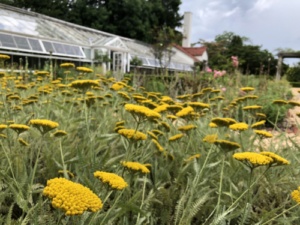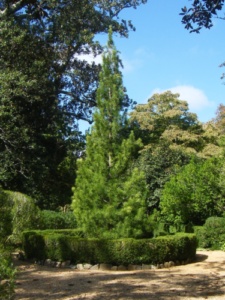The Plant Box

The discovery of a garden journal is the Holy Grail for anyone interested in learning about the making of a historic landscape. Here in the South, gardeners such as Thomas Jefferson (Virginia), Martha Turnbull (Louisiana), and Elizabeth Lawrence (North Carolina) documented their horticultural successes and failures in journals, diaries, and books. Their writings provide fascinating insight into their pursuits, often including plant names, varieties, blooming dates, and other details. While perhaps appearing outdated initially, these primary historical sources are derived from hard-earned personal experience and are often a great resource for current gardeners, particularly those cultivating plants in the same climatic region.
Gardening has been an ongoing pursuit at Hills & Dales for well over 175 years, so you would expect that some records would survive, likely providing some good ideas for gardeners in our area today. Though the bones of the garden laid out by Sarah Ferrell in the 19th century remain, and numerous historic photographs of it survived, we have never discovered any detailed writings of hers about her work. Given her education, botanical interest, and refined nature, I suspect she chronicled some of her efforts, but to date, no such cache has been found. Likewise, we have some notes, observations, and records from Ida Cason Callaway’s gardening between 1916 and 1936, but her true trove of information, if it exists, remains elusive. For Hills & Dales, the real garden treasure comes from the garden’s last owner, Alice Hand Callaway, who left a “Plant Box” documenting many of her gardening pursuits.
This gem is a sturdy paperboard fling box reinforced with blue tape on the folding seams. It resided in her Flower Room before being cataloged into our archival collection as A1998.1.171. Originally designated for letters, it was repurposed at least twice, once for Red Cross Blood Donor Services, and lastly to become Alice’s garden plant file. Following in her mother-in-law’s footsteps, Alice gardened at the estate from 1936 until her passing in 1998, and the box contains plant records spanning most of that time. The first entry records an espaliered pear planted in 1938, while the last entries in 1997 include a geranium (Armenian cranesbill), wheel tree, American wisteria, and a small collection of baptisias obtained from Tony Avent’s then newly founded Plants Delights Nursery in North Carolina.
It teems with mostly hand-written plant lists organized in alphabetical order, but also contains typed inventories of her most prized collections, plus original nursery orders, and a few letters related to sharing plants with fellow gardeners. The contents provide us a window into Alice’s gardening world. They document her almost insatiable desire to try new plants, her successes, her failures, and her favorite species. She was adventuresome, indeed, and her recordings provide many lessons that are relevant for today’s gardeners.
Beginning with Acanthus mollis (bear’s breeches) and stretching to yew and ‘Coronation Gold’ yarrow. The box contains well over 500 individual plant records. Every entry includes the following headings: Bought From, Date, and Where Planted. Sometimes other details are also provided. Plants are mostly fled under their botanical name, but periodically placed under their common name. Based on the large number of entries, we can easily surmise that Alice’s favorites included azaleas, begonias, camellias, clematis, conifers, ferns, geraniums, ivies, jasmines, magnolias, orchids, and rhododendrons.
We learn from the file that most of her plant purchases were from established specialty nurseries. Plants came from well-known southern nurseries including Fruitlands, Glen Saint Mary, Hastings, Thomasville, Wayside, and others. For plants not readily available in the South, she would go further afeld. Specialty magnolias were shipped to her from Gossler Farms in Oregon, tropical plants came from Logee’s in Connecticut, antique roses and maidenhair ferns arrived from nurseries in California, while native ferns and conifers came from Vermont and New York. Alice was not adverse to local purchases or a good deal, however! She purchased 3 tropical fcus trees from K-Mart in 1978, and in 1983, she bought 9 H.H. Hume azaleas from Winn-Dixie for $1.49 each and planted them “on top the wall by the well.”
She also obtained plants from fellow gardeners. In 1979, Alice got the beautiful gloriosa lily from Retta Jelks of Savannah and planted it “by well by God.” It still grows in the garden today, but is where she subsequently relocated it, on the Southside of the greenhouse. Similarly, in 1994, she received the very rare ‘Daybreak’ magnolia from August E. Kehr of Hendersonville, North Carolina. Unfortunately, that plant was lost. The peace lily (Spathiphyllum wallisii) in the greenhouse was given to her by Hal Hentz, one of the architects of the home! Alice also recorded receiving plants from Fred Galle at Callaway Gardens, the Arnold Arboretum, the State Botanical Garden of Georgia, and the Brooklyn Botanical Garden.
For our gardening staff, the lists provide the perfect trifecta of plant name, garden location, and date of planting. For example, it is exciting to learn that golden spider lily (Lycoris aurea) was purchased from Hastings and planted on Florida Lane in 1973. If we find that the plant has disappeared, we can reintroduce it and keep the garden more like Alice Callaway envisioned it. We would certainly consider that a preservation victory!
Careful study of the box’s contents reveals that Alice Callaway was working to grow a wide variety of unique plants. Some rare exotic woody plants she grew included Japanese umbrella pine, katsura, dove tree, and Japanese stewartia. On the native side, she cultivated Georgia bark, fothergilla, American wisteria, American yellowwood, summersweet, and others. While she tended toward woody plants, she also grew a wide and adventurous assortment of herbaceous perennials including agapanthus, bergenia, surprise lily, bugbane, peonies, pineapple lily, baptisias, and numerous others.
Sprinkled throughout the lists in parentheses or red ink are the words “LOST” or more rarely “DIED.” These are by far the saddest words, indicating that her efforts to grow a particular plant had failed. Interestingly, to improve her chances of success, Alice would purchase multiple plants and locate them in different spots in an effort to determine the ideal location. This worked for Italian cypresses planted in 1983, most of which still survive, but all ten of her double flowered Japanese cherries died in 1985. Similarly, if she was unsuccessful growing a prized plant the first time, she might just try it again as she did with Japanese umbrella pine and others.
“The Plant Box” is indeed the Holy Grail of Alice Callaway’s six decades of gardening at Hills & Dales. During that time, she became a more accomplished gardener and this file contains the best surviving documents of her horticultural pursuits. For those currently gardening in Georgia and Alabama, it’s filled with lessons and good plant ideas gained from a lifetime of experience. Let’s hope in the future we might discover a similar treasure from Sarah Ferrell and/or Ida Cason Callaway. Now that would be special! ~ CBW

Alice’s “Plant Box” gardening journal on display in the Flower Room. |

A small sample of plant records found in the “Plant Box.” |

Visitors can see ‘Coronation Gold’ yarrow growing in the herb garden each year. |

Gloriosa lily. Photo by Cheryl Jackson. |

Umbrella pine growing on the 4th terrace. |

Purple American wisteria. |
View this entire Portico Newsletter: